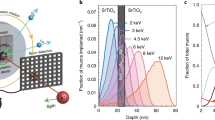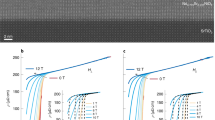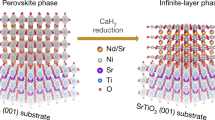Abstract
SEVERAL classes of copper oxide compounds are high-temperature superconductors1–3; the highest known transition temperature (Tc) is 122 K for Tl2Ba2Ca2Cu3O11 (ref. 4). Superconductivity has also been observed in oxides containing early transition metals, but the superconducting transition temperatures are substantially lower. (The highest known Tc for an early transition metal oxide is 13.7 K, for the spinel compound LiTi2O4 (ref. 5).) Whereas all of the copper oxide superconductors have very anisotropic structures, the superconducting oxides of early transition metals discovered up to now have three-dimensional structures. Here we report the discovery of a new class of superconductors, LixNbO2 with layered structures. At low applied magnetic fields, the magnetic susceptibility greatly decreases to diamagnetic values below 5.5 K for Li0.45NbO2 and below 5.5 K for Li0.45NbO2; this transition indicates the onset of superconductivity. In this first example of superconductivity in a layered early transition metal oxide, it is interesting to note that the layering has not increased Tc to new levels for early transition metal oxides.
This is a preview of subscription content, access via your institution
Access options
Subscribe to this journal
Receive 51 print issues and online access
$199.00 per year
only $3.90 per issue
Buy this article
- Purchase on Springer Link
- Instant access to full article PDF
Prices may be subject to local taxes which are calculated during checkout
Similar content being viewed by others
References
Bednorz, J. G. & Müller, K. A. Z. Phys. B64, 189–193 (1986).
Wu, M. K. et al. Phys Rev. Lett. 58, 908–910 (1987).
Sheng, Z. Z. & Herman, A. M. Nature 332, 55–58 (1988).
Parkin, S. S. P. et al. Phys. Rev. Lett. 60, 2539–2542 (1988).
Johnston, D. C. et al. Mater. Res. Bull. 8, 777–784 (1973).
Meyer, G. & Hoppe, R. J. less-common Metals 46, 55–65 (1976).
Kumada, N. et al. J. Solid St. Chem. 73, 33–39 (1988).
Burdett, J. K. & Hughbanks, T. Inorg. Chem. 24, 1741–1750 (1985).
Bardeen, J., Cooper, L. N. & Schrieffer, J. R. Phys. Rev. B106, 162–164 (1957); Phys. Rev. B108, 1175–1204 (1957).
McEwen, C. S. & Sienko, M. J. Rev. chim. Miner. 19, 309–316 (1982).
de Picciotto, L. A. & Thackeray, M. M. Mater. Res. Bull. 20, 187–195 (1985).
Author information
Authors and Affiliations
Rights and permissions
About this article
Cite this article
Geselbracht, M., Richardson, T. & Stacy, A. Superconductivity in the layered compound LixNbO2. Nature 345, 324–326 (1990). https://doi.org/10.1038/345324a0
Received:
Accepted:
Issue Date:
DOI: https://doi.org/10.1038/345324a0
This article is cited by
-
Antiferromagnetic skyrmion crystals in the Rashba Hund’s insulator on triangular lattice
Scientific Reports (2021)
-
The Synthesis and Thermoelectric Properties of p-Type Li1−x NbO2-Based Compounds
Journal of Electronic Materials (2017)
-
Nanoarchitectured Nb2O5 hollow, Nb2O5@carbon and NbO2@carbon Core-Shell Microspheres for Ultrahigh-Rate Intercalation Pseudocapacitors
Scientific Reports (2016)
-
Synthesis, structure, and properties of mixed niobium(IV,V) oxides
Inorganic Materials (2000)
-
X-ray spectra and electronic structure of Li x NbO2 superconductor and other niobium oxide compounds
Zeitschrift f�r Physik B Condensed Matter (1994)
Comments
By submitting a comment you agree to abide by our Terms and Community Guidelines. If you find something abusive or that does not comply with our terms or guidelines please flag it as inappropriate.



